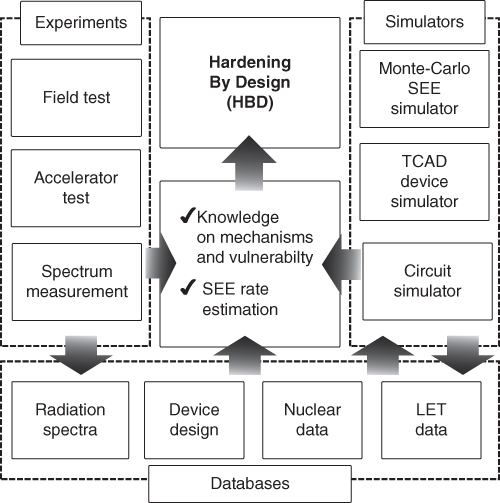Chapter 6Integrated Device Level Simulation Techniques
6.1 Overall Multi-scale and Multi-physics Soft-Error Analysis System
Figure 6.1 illustrates the overall macroscopic soft-error analysis system SECIS (SElf Consistent Integrated System for terrestrial neutron soft error) [1–4] introduced in this chapter, which consists of the following activities:
- SEE (Single Event Effect) -MC (Monte-Carlo) simulators, CORIMS (COsmic Radiation Impact Simulator and SEALER (Single Event Adverse and Local Effects Reliever)
- Programming language Visual Basic™ is used for many reasons. (see Appendices A.3 and A.4),
- TCAD (Technology Computer-Aided Design) device simulators,
- an automatic device model builder based on the device layout database GDS (Graphic Data System)-II
- database handler based on SQL (see Appendices A.5 and A.6),
- databases of LET (Linear Energy Transfer), isotopes, nuclear reactions, materials, geophysics and terrestrial radiation spectra.
- the Sun's activity data,
- field neutron data,
- field soft-error data,
- GPS (Global Positioning System) data of the fields and
- irradiation data for single event effect (SEE) cross sections at the accelerators.

Figure 6.1 Overall scheme of SEE simulation/evaluation/hardening system
Databases referred to above enable realistic simulations and validate simulation results. As a typical device, SRAM (Static Random Access Memory) models are used for ...
Get Terrestrial Radiation Effects in ULSI Devices and Electronic Systems now with the O’Reilly learning platform.
O’Reilly members experience books, live events, courses curated by job role, and more from O’Reilly and nearly 200 top publishers.

